
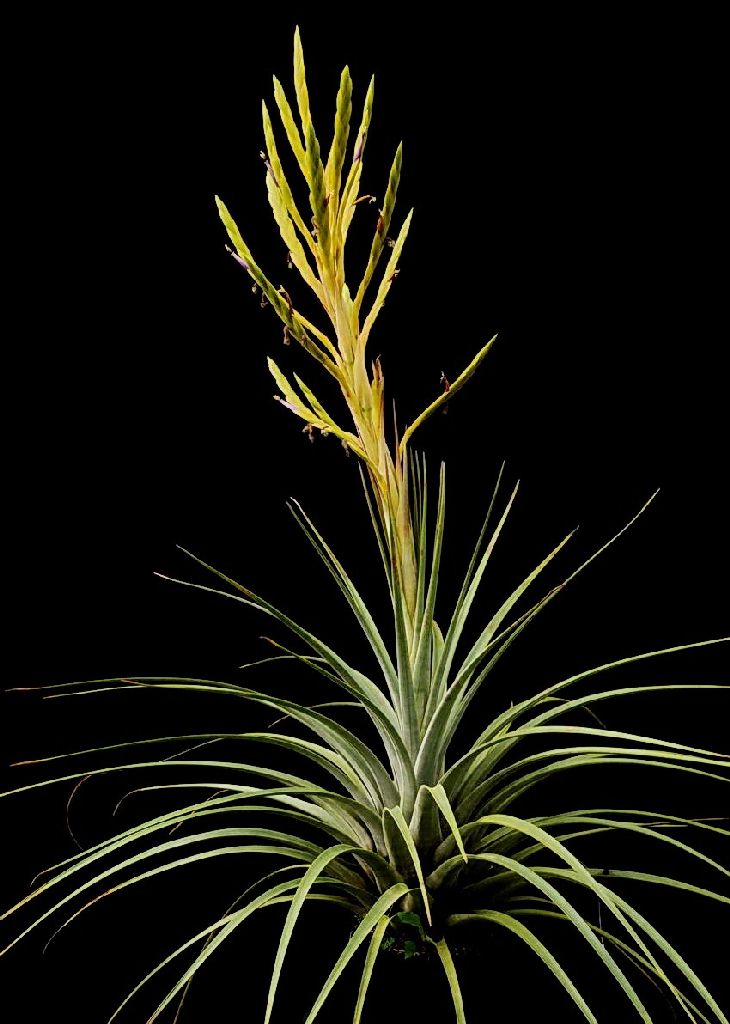
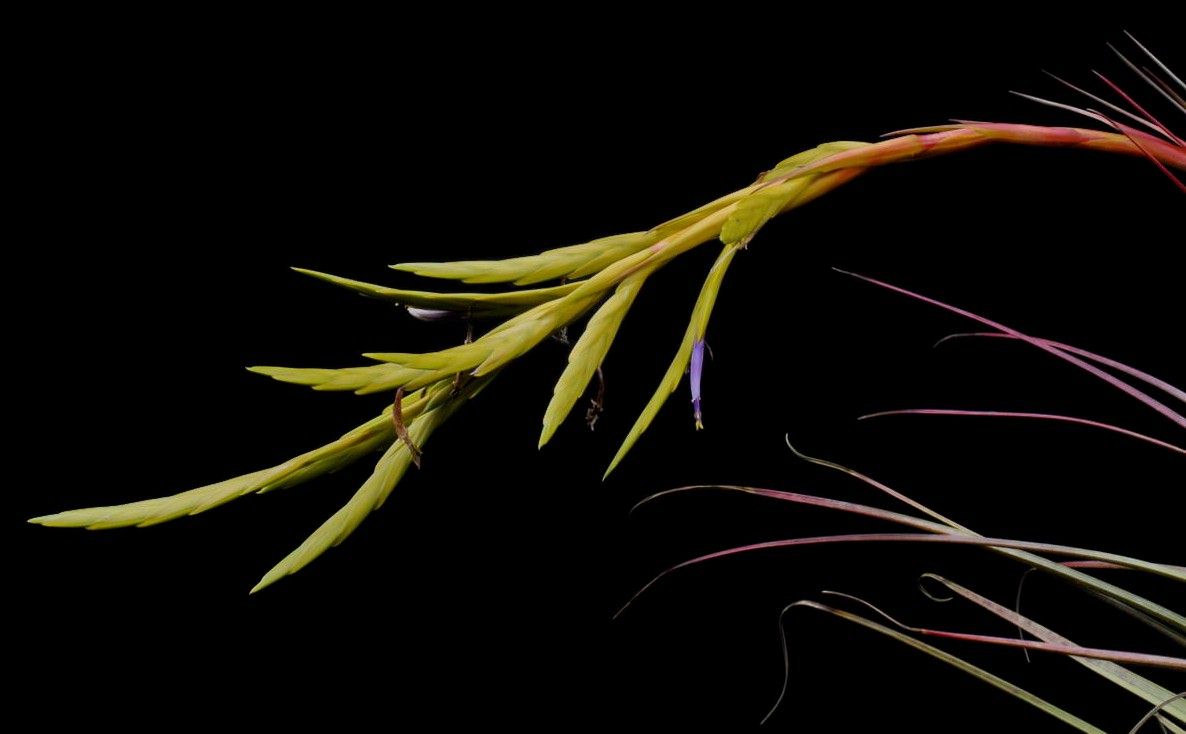
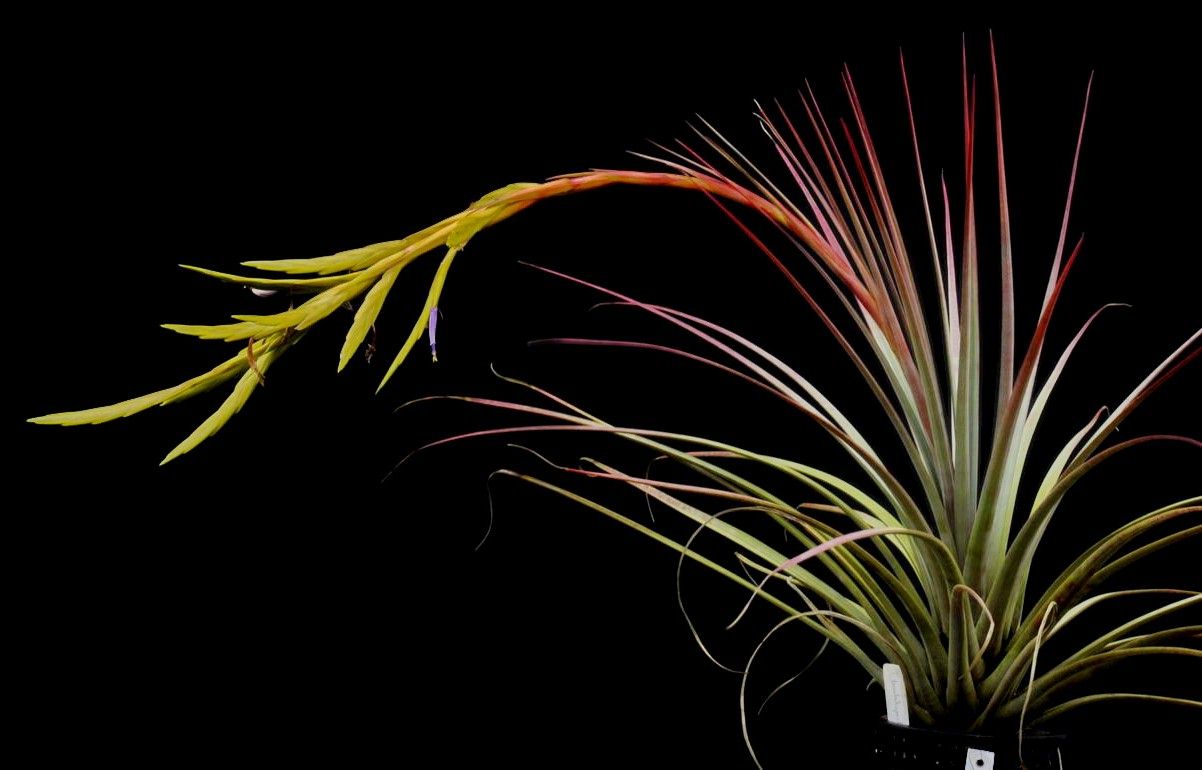
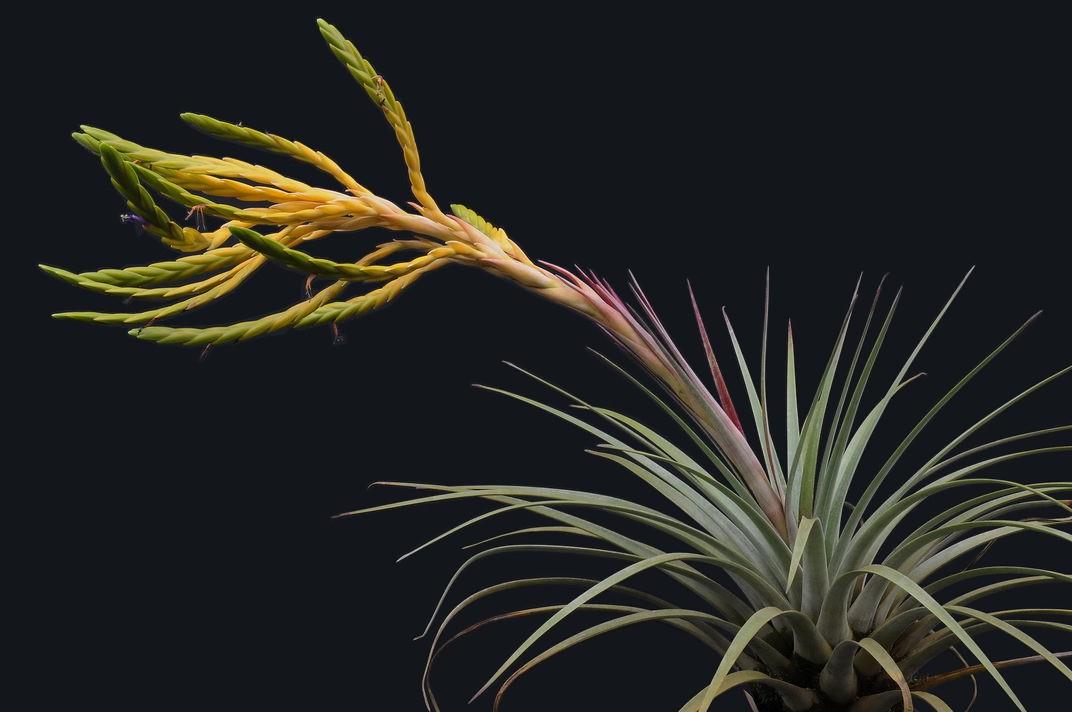

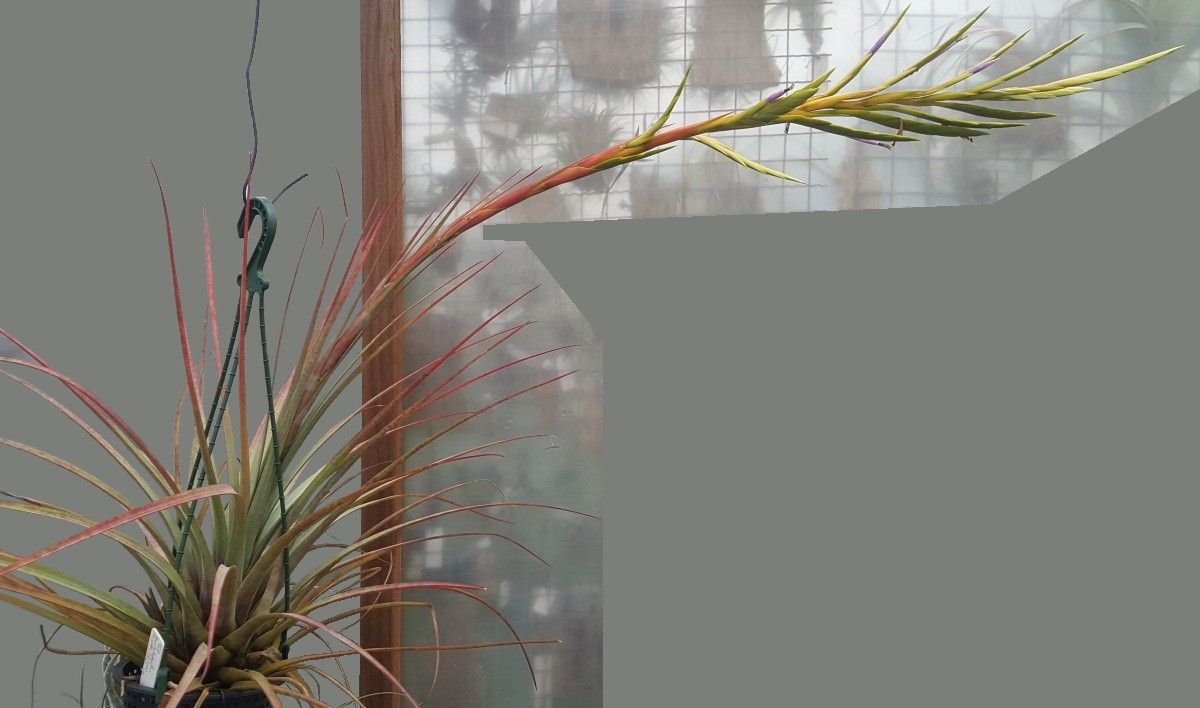
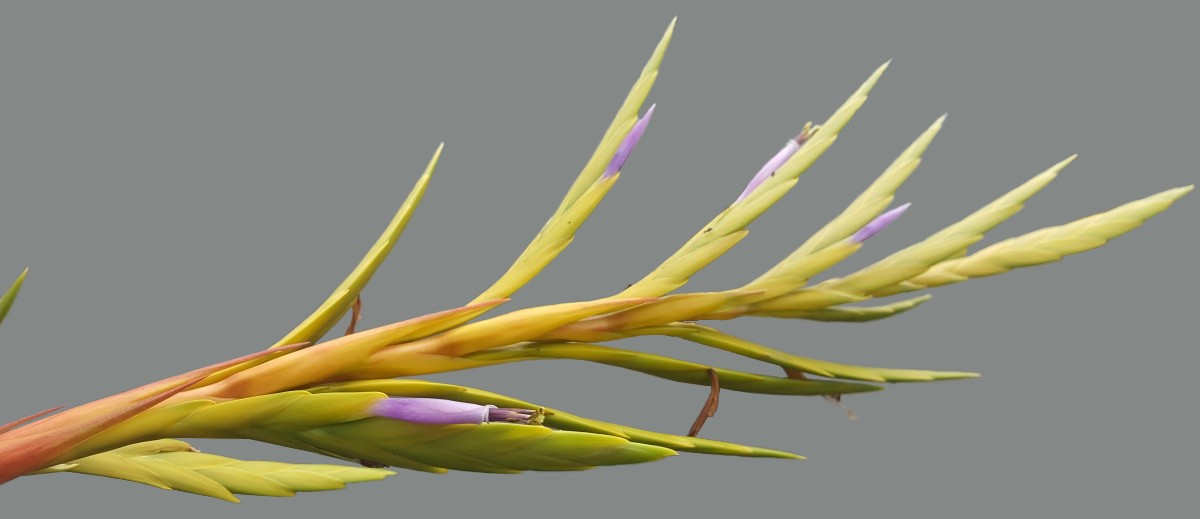
TYPE. Carlos Beutelspacher 53 (holotype MEXU), on rocky bank, km 17 of Carretera Tuxtla Gutierrez to El Sumidero, El Mirador, 1200 m alt, Chiapas, Mexico, May 1971.
DlSTRIBUTION. Known from the type collection only.
Examination of living plants brought into cultivation by Pamela Koide has shown that several reported characteristics of this species do not exist! Most important the stamens and style are conspicuously exserted at anthesis and the anterior sepal is free from the posterior pair. T. beutelspacheri is not at all related to the Allardtia (very few of which grow as far north as Mexico) but is very closely related to T. fasciculata.
Tillandsia insignis Matuda, Cact. & Sucul. Mex. 16: 91, fig. 48. 1971
(Translated by Butcher)
Plants large, acaulis, rupicolous. Leaves coriaceous, very rigid, with longitudinal nerves, 50-60 cm long, 1.5 cm wide, gradually acuminate, scaled on both faces; sheaths oval, dark coffee, 12 cm long to 6 cm wide. Scape thick, exceeding the leaves. Scape bracts imbricate, amplexicaule, sharp pointed, longer than the internodes, rose. Inflorescence hanging arched, bipinnate, brilliant yellow; with 10-12 branches (spikes) strongly complanate, distichous, each branch with up to 28 flowers dispersed along a section of 25-30 cm. Floral bracts coriaceous, carinate, very flat, 5 cm long, 2 cm wide, yellow: Sepals coriaceous, free carinate, the lower middle connate forming a tube, narrow, 4 cm long, 4 mm wide; Petals violet, standing out from the sepals at anthesis, lanceolate, acute, 2.5 cm long, 5 mm wide; forming a tube 2 cm long; stamens included.
Mexico: Chiapas; El Mirador, km. 17 Carretera Tuxtla Gutierrez al Sumidero, en ladera rocosa, 1,200 mt de altitud. Tipo: Carlos Beutelspacher No. 53, mayo de 1971, depositado en el Herbario Nacional, Instituto de Biologia de la Universidad Nacional Autonoma de Mexico.
It is a truly extraordinary Tillandsia for its form and size, and somewhat without parallel.
Introducing: Tillandsia beutelspacheri Matuda by Harry E. Luther in Journ Brom Soc 44(3): 117-118. 1994
Tillandsia beutelspacheri was first described in 1971 by Dr. Eizi Matuda who, unaware of a previous use of the specific epithet, {Tillandsia insignis (Mez) L.B. Smith & Pittendrigh, 1953. Based on Morren's painting of Pepinia insignis. The final generic placement of this very problematic taxon is far from settled.} named it Tillandsia insignis. This oversight was corrected in 1974. {Readers interested in the literature should consult the Flora Neotropica monograph 14, part 2, page 759.}
Nothing new has been added to our knowledge of this species since Dr.Lyman Smith's treatment in the Flora Neotropica monograph 14, part 2 where it was included in Tillandsia subgenus Allardtia based on the original description's statement of included stamens.
Examination of living plants, brought into cultivation by Pamela Koide, has shown that several reported characteristics of this species do not exist! Most important, the stamens and style are conspicuously exserted at anthesis and the abaxial sepal is free from the pair of adaxial sepals. Tillandsia beutelspacheri is not at all related to the Allardtia tillandsias (very few of which grow as far north as Mexico) but is really very closely related to Tillandsia fasciculata; I'm sure a case could be made to include it as a variety although this would even further complicate the circumscription of this variable species (or complex of species). At any rate, Tillandsia beutelspacheri cannot be identified by the keys to Tillandsia in the Flora Neotropica monograph 14.
To introduce this species to hobbyists and to correct the published description, the following synopsis of Tillandsia beutelspacheri is given.
The plant is lithophytic and densely clustering. The leaves are stiffly spreading; the leaf blade is very narrowly triangular, 30-60 cm long, 10-25 mm wide, cinereous-lepidote (more so abaxially); the leaf apex is thick and subulate. The scape is erect. The inflorescence is digitate with three to twelve branches, at first it is erect, then arcuate and finally nutant as the flowering progresses. The floral bracts are 35-50 mm long and bright yellow with a white lepidote apex. The sepals are 30-40 mm long, rather thin, yellow-green, the adaxial pair of sepals is carinate and more than ½ connate, the abaxial sepal is free and ecarinate. The corolla is tubular, 45-55 mm long and blue violet. The stamens and style are conspicuously exserted at anthesis.
So far as is known, Tillandsia beutelspacheri is restricted to the vicinity of the Sumidera Canyon in the state of Chiapas, Mexico.
Plants appear to grow equally well in pots or mounted on cork or driftwood.
Notes from Derek Butcher:
In early 1993 I found my T. beutelspacheri ex Cork did not agree with the description
This is the correspondence
From Selby (Harry Luther)30/3/1993
T. beutelspacheri may be an odd form of T. fasciculata with a yellow pendant inflorescence. I don’t put much faith in the cited included stamens. Your plant is not the same as T. beutelspacheri. The bracts and flowers are smaller in addition to the erect inflorescence. Possibly it is a type of T. fasciculata or a hybrid with T. rodrigueziana or welzii. The floral bracts are not typical for both T. fasciculata and beutelspacheri if the latter is real.
From Ehlers 23/5/1993
As to T. beutelspacheri – the Matuda description is wrong in many details. The plants from the type locality have exserted stamens and the anterior sepal is entirely free, they are not connate to a tube! Normally the inflorescence is sub-pendant. I have plants also from the Sumidero canyon that are much smaller and have an erect inflorescence of a simple spike. I wanted to describe it as T. beutelspacheri var. unispica. What do you think? There are varieties that show less differences – but you write that your flower stem is erect too.
From Ehlers 1/7/1993
I already made a description from a plant which we collected at the type locality and which resembles the photo by Matuda but did not publish it so far. I do not think it is a form of T. fasciculata, it seems to be a good species though the stamens are excluded and the petals do not form a tube. In the typical plants the inflorescence bends soon and before anthesis. Most of the plants at the habitat have declined inflorescences. But there are some plants with erect inflorescence and as I wrote you there is a number of plants we collected at the same place that have an erect inflorescence and only one spike (And I wonder if it is worth being called var. unispica). I sent the description to Till but so far have not got an answer. If he agrees, I wanted to describe the variety unispica and at this occasion publish the description of T. beutelspacheri with the corrections. As to Pamela Koide she has a plant that she calls T. beutelspacheri ‘Red Spike’ which I received from her – I am sure this is a hybrid (Butcher’s comment – Is this xbergiana?)
From Ehlers 16/8/1993
As to T. beutelspacheri they are from the same locality – the Sumidero Canyon near Tuxtla Gutierrez in Chiapas. It grows with T. socialis and T. ionantha var. van hyningii. The plants look like the photo from Matuda but differ mainly in the free anterior sepal and the stamens much excluded. I am not sure if it is a good idea to make the one-spiked plant with the erect inflorescence a variety. What do you think? They are from the same canyon. I have another species from that canyon with short spikes and lepidote bracts. I hesitate to publish it as it might be a hybrid. But I don’t know any parents. The only other plants growing in the area besides the above mentioned are T. fasciculata, T. belloensis, T. capitata and maybe T. flabellata. None of them have short spikes and lepidote floral bracts. I hope to be able to go there again to do more field studies. But it is not easy there – the rockwalls are 400m and very steep!
Tillandsia beutelspacheri Matuda var. unispica ??? Ehlers as at 1992 Not yet published
Plant flowering 40 cm high.
Leaves about 25, in a funnelform rosette, to 25 cm long, coriaceous, with asymetric keel, green adpressed lepidote.
Sheaths 3 cm long, 2,5 cm wide, ovate, adaxial dark, abaxial lighter brown, finely brown adpressed lepidote.
Blades to 25 cm long, 1 - 1,5 cm above the sheath, narrowly triangular, acuminte, suberect, adax. slightly nerved, very finely adpressed lep, apearing green, abaxially very densely covered with grey coarse trichomes.
Scape 10 - 16 cm long, erect, equaling or shorter than the rosette.
Scapebracts densely imbricate, scape slightly visible, lower ones subfoliaceous, the upper ones similar to the floral bracts, their sheaths about 3 cm long ( 2 x the internodes), yellow, adaxially nerved, punct. lepidote, adaxially densely subpruinouse lepidote, blades short, acuminate - cucullate.
Inflorescence erect, simple, distichous, spike about 15 cm long, 2- 3 cm wide, complanate, lanceolate to linear, densely 12 - 15 flowered (rhachis at time of anthesis not visible), plus 2 - 3 sterile bracts ast the base.
Floral bracts 4,3 cm long to 2 cm wide, elliptic, acute, slightly cucullate, coriaceous, bright yellow, adax. nerved and punctl. lep., abax glabrous but at apex with big grey trichomes, carinate only towards apex.
Sepals 3,5 cm long, 5 - 6 mm wide, lanceolate, acute, coreaceous, nerved, yellow, the posterior ones about half connate und carinate.
Petals 6 - 6,5 cm long, 9 mm wide, 7mm at base, tubular - erect, the tips slightly curled back, violet, l cm white ast base.
Stamens exserted. Filaments in 2 sets, to 7.3 cm long apically violet and l mm wide, oval, thin and white towards base. Anthers 4 mm long, 1 mm wide, elliptic, versatile fixed 1/3 from base, brown. Style 6.5 cm long, apically violet and twisted, white towards base. Stigma 2 mm long, 1.5 mm wide, lobes erect, lilac, Typ I,
Ovary 8 mm long, 4 mm wide at base, conical.
Type Mexico, Chiapas, Sumidero-Canon near Tuxtla Gutierez, above Mirador. EM 890609 leg Klaus und Renate Ehlers ............. l989. WU.
The plant was collected as T. beutelspacheri. Because all plants in this location of T. beutelspacheri lean over, are we not dealing with a variety?
The plant differs from T. beutelspacheri Matuda as follows: plant much smaller, leaves much shorter and narrower, Scape erect, Inflorescence simple, spike small.